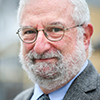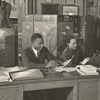On November 23, 2021, a federal jury in Charlottesville, Virginia, held five organizers of the 2017 Unite the Right march responsible for injuries inflicted on nine people when the march turned violent. The jury awarded the plaintiffs in Sines v. Kessler more than $25 million. Many Americans greeted the verdict as a clear condemnation of hate speech.

Resurgent nationalism in the United States has strained the legal system’s ability to protect free speech while providing justice to communities devastated by racialized violence like the Tree of Life Synagogue in Pittsburgh. Official White House Photo by Andrea Hanks. Public domain
This civil case stood in for criminal prosecutions that fizzled when judges held the relevant statutes unconstitutional. The sole criminal prosecution was of the man who drove his car into a crowd of counterprotesters, killing Heather Heyer. Thus, even though the Sines verdict came as a relief, it served only partial justice. The financial penalty seems insufficient, and the defendants are pleading poverty. Further, those responsible for the protest raise and launder their money online, making it much more difficult for the courts to strip them of physical assets, an approach used against the Ku Klux Klan as recently as 2008. If the defendants are eventually made to pay, nothing stops them from continuing to raise money in the shadow of the law; they prefer contributions in untraceable Bitcoin. Meanwhile, counterprotesters will cope with physical and psychological injuries for years, if not for the rest of their lives.
A marriage of racism, white Christian nationalism, and antisemitism fueled the violence in Virginia. The rioters came to Charlottesville to protest the removal of a statue of Robert E. Lee from a city park. As they invaded the University of Virginia grounds the night before, however, they chanted “Jews will not replace us.” Their antisemitism was not ancillary to their racism. Rather, it was a cornerstone of their plans to upend American society to, among other things, prevent the Jewish takeover they fear—baselessly—is coming.
Sines v. Kessler rings the same bells we have often heard in the past century when victims used the legal system to confront hate-mongering. This is in part because US law has a strange relationship to speech. We prefer a hands-off approach up to the moment speech incites violence or property damage. But once it crosses that boundary, once it is clear that a particular utterance or protest has become actionable before the law, the legal remedies available don’t sufficiently address the injuries to individuals and society alike. Despite guilty verdicts in these cases, the incentive for those who would espouse hate to weaponize speech remains.
The popular optimism generated by the Charlottesville verdict will probably give way to old frustrations. One defendant, Andrew Anglin, owner of the neo-Nazi website the Daily Stormer, left the country in 2018 to avoid paying millions for online harassment and has not been seen since. Two others, Richard Spencer and Jason Kessler, while representing themselves in the civil case, ran podcasts after each day’s proceedings to rally supporters and raise more money.
Their antisemitism was not ancillary to their racism.
None of these tactics are new. During World War I, noted antisemite Henry Ford criticized the press for filtering his public statements, just as many of today’s right-wing pundits complain (on cable news!) about being “canceled.” Lacking a podcast or a YouTube channel, Ford purchased the Dearborn Independent in the 1920s, filling its weekly issues with antisemitic screeds loosely based on the Protocols of the Elders of Zion.
The Protocols purports to be the records of a Jewish conspiracy to take over world governments and financial systems. Despite the ludicrous premise, during the decade prior to World War I, the Protocols inspired pogroms in Russia and swiftly spread across Europe. The text confirmed Ford’s beliefs about Jews’ responsibility for the war and their ulterior motives for serving in President Wilson’s administration. The Protocols remains a touchstone for antisemites everywhere, from the shooter who attacked the Poway, California, synagogue in 2019 to the QAnon imagining of a deep state.
Ford’s career as a hate speech publisher was short lived. Facing a federal libel suit, Ford positioned himself as the victim of unscrupulous, profiteering Jews. But the trial revealed that his newspaper was riddled with errors, fatally undermining his defense. To avoid an adverse verdict, he secured the declaration of a mistrial. First, he staged a car accident, supposedly with himself at the wheel, that the press immediately concluded was an assassination attempt. Then he planted an interview in a newspaper in which a juror asserted that Ford was disrupting the trial. The judge promptly ended the proceedings, but before a new trial could begin, Ford publicly apologized. The articles, he said, were the work of employees who published without his knowledge. That assertion was untrue. Trial testimony had established that Ford was not only aware of what they contained, but he personally ordered the attacks on plaintiff Aaron Sapiro.
The outcome deprived Sapiro, who had nearly bankrupted himself in suing Ford, of the satisfaction of a guilty verdict. But the apology made it impolitic to continue, and Sapiro chose to accept an out-of-court settlement that included money damages and Ford’s pledge to close the newspaper. Ford’s hateful words, however, far outlasted the lawsuit’s power to constrain him. Published as a book under the title The International Jew: The World’s Foremost Problem, the Independent’s articles swiftly spread to all corners of the earth. Like the Protocols, The International Jew still enjoys a prolonged literary half-life, both in print and on the internet.
Thus, the antisemitism of czarist Russia, filtered through the cultural imprimatur of America’s foremost industrial king, supplied the canon of later antisemites. Though Ford was eventually stripped of his media platform, other politicians soon adopted his message. Gerald L. K. Smith, an avowed Nazi supporter and a founder of the America First Party, was a Ford confidant beginning in the 1930s. During World War II, Smith proclaimed the existence of an international Jewish conspiracy, and he published his own version of The International Jew in the 1950s. Alabama governor George C. Wallace blamed Jews for stirring up Black agitators during the 1960s. Richard Nixon and the Reverend Billy Graham were recorded in the Oval Office in 1972 affirming each other’s suspicions about Jews’ control of Hollywood and the media. The Charlottesville defendants, who host their websites on the dark web and use encrypted apps to communicate with their alt-right followers, are merely the most recent links in the chain.
The verdict in Charlottesville is more of a challenge than a victory.
If Ford’s trial and its aftermath provide a lesson, it is that the verdict in the Charlottesville case is more of a challenge than a victory. On one level, the victims deserve justice. They deserve to be made whole, or as close as practicable. That will require substantial effort before the court can issue asset forfeiture orders; the burden of investigating the money trail falls on the plaintiffs. On another level, the injury to us as a society remains an open wound. The legal paradigm that has governed hate speech regulation for more than a century was the brainchild of Justice Louis Brandeis, the first Jew to sit on the US Supreme Court. Brandeis’s answer to speech one disagrees with or condemns was more and better speech. His model teaches that in the marketplace of ideas, facts and truth will conquer hate, conspiracy theories, and fascism.
They haven’t. The fight is ongoing, and a single verdict, even one worth $25 million, will not be enough to cripple the movement that the defendants represent. Indeed, our legal system is not only ill equipped to heal this wound; it often leaves it to fester. One unavoidable consequence of trials adjudicating hate speech is that these ideas continue to gain historical permanence; they exist in the discourse as a reference point for everyone, and that means we are continually refighting the last war. Charlottesville and the Sines trial returned ideas we thought discredited to the national stage, with bloody results. In the decades before Charlottesville, antisemitic acts consisted almost entirely of vandalism, such as the painting of antisemitic slogans on park equipment, leafleting at colleges and universities, and damage to synagogues. Then, in October 2018, a shooter killed 11 and wounded six at the Tree of Life synagogue in Pittsburgh. That shooter, who had no criminal record, asserted that Jews were “the enemy of white people.” The Poway attack happened six months later.
After Charlottesville, American neo-Nazis became less centrally organized; many lost their jobs after being identified as participants. But their radicalization continues to spread. Rep. Marjorie Taylor Greene (R-GA) has alleged that Jews use “space lasers” to attack their enemies. An obscure CEO opined that Jews intend to use the COVID vaccine to “euthanize Americans.” Antisemites on both sides of the Atlantic blame George Soros for all manner of political manipulations. And the Charlottesville verdict came too late to discourage the Capitol rioters in January 2021, where antisemitism was once again a driving force behind the violence: a participant wore a T-shirt that day depicting Auschwitz as a summer camp.
As with Charlottesville, concerns continue to build that the organizers of the Capitol riot will evade punishment and that this lack of accountability will embolden others to violence. Ultimately, the issue is whether a legal verdict—the judgment of a court of law—can discredit the antisemitic convictions that are antithetical to our democracy. If Justice Brandeis’s model of a free market in ideas is to remain the cornerstone to interpreting the First Amendment, the penalties for crossing from words into violence must be clear and severe. We need to prosecute criminal conspiracy, terrorism, and racism-fueled violence consistently and forcefully, and we need better protections for peaceful protesters exercising their First Amendment rights. Instead, since 2017 36 states have passed laws making it easier to arrest protestors and immunizing those who run them down with automobiles. Such a statute would have made it impossible to hold the driver who killed Heather Heyer financially responsible for her death, much less convict him of her murder.
Giving white nationalists license to kill is not the answer. Well-meaning popular and academic attempts to counter hate speech in the marketplace of ideas have failed to disarm it. To fulfill the law’s promise to people harmed by this kind of violence and to end this age-old cycle, the legal system must make jury verdicts meaningful and not just an empty letter.
Victoria Saker Woeste is the author of Henry Ford's War on Jews and the Legal Battle against Hate Speech. She tweets @VictoriaSWoeste.
Tags: Features North America Legal History Social History

This work is licensed under a Creative Commons Attribution-NonCommercial-NoDerivatives 4.0 International License. Attribution must provide author name, article title, Perspectives on History, date of publication, and a link to this page. This license applies only to the article, not to text or images used here by permission.
The American Historical Association welcomes comments in the discussion area below, at AHA Communities, and in letters to the editor. Please read our commenting and letters policy before submitting.
Comment
Please read our commenting and letters policy before submitting.










